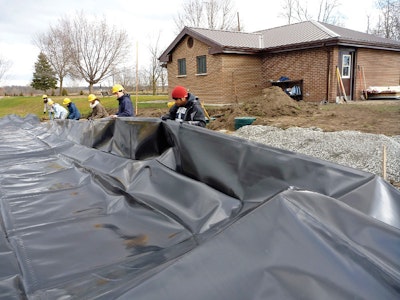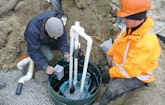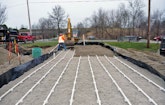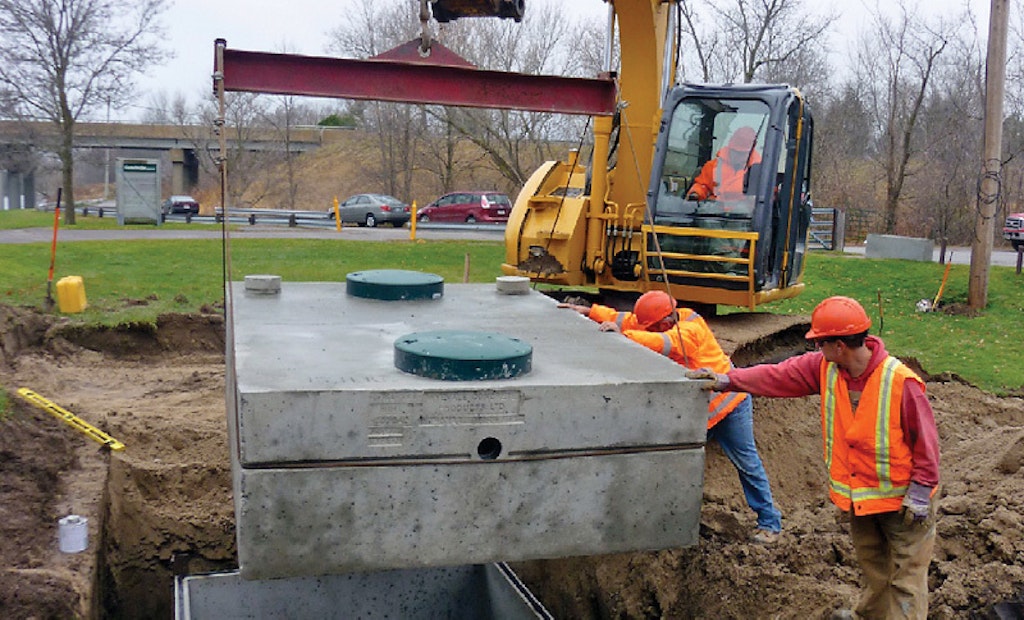Interested in Systems/ATUs?
Get Systems/ATUs articles, news and videos right in your inbox! Sign up now.
Systems/ATUs + Get AlertsLake Simcoe, the largest inland lake in southern Ontario, suffers from acute nutrient loading. Environment Canada was concerned about contamination even from the restroom used by motorists and boaters enjoying the park at Lock 41 Station.
Although the conventional onsite system with tile lines in a sand filter was working, Environment Canada chose the site for a pilot project to test a technology that could provide long-term protection of the watershed. Centre for Sustainable Watersheds, a nonprofit environmental organization in Portland, Ont., provided the engineered ECOCYCLET ZeroDischarge closed-loop evapotranspiration bed.
“It’s not a wetland cell because the recirculated wastewater either evaporates or is drawn up by plants,” says president Bob Sneyd. “There is absolutely no discharge.” The system will go online in mid-May when the lock opens for the season.
Site conditions
Soils are clay with a percolation rate of 50 minutes per inch. Operating the lock raises and lowers the water table 10 feet. The system parallels the canal. The lock, owned by Parks Canada, is part of the Trent-Severn Waterway National Historic Site of Canada.
System components
Robin Smith, P.E., of Robin Smith Engineering in Hillsdale, Ont., designed the system to handle 172 gpd based on a peak of 75 toilet activations per day. The major components are:
- Existing 2,000-gallon two-compartment concrete septic tank.
- Existing 430-square-foot sand filter with gravity-fed 3-inch tile distribution lines.
- 2,000-gallon two-compartment concrete recirculation tank from Wyevale Precast.
- Biotube simplex pump vault and simplex control panel from Orenco Systems.
- Two distribution valve chambers from Rain Bird Corp.
- Two aeration injectors from Mazzei Injector Co.
- ECOCYCLET ZeroDischarge Wastewater Systems.
System operation
Wastewater flows into the septic tank, then to the recirculation tank. Because the evapotranspiration rate in the vegetation bed varies, pump cycles depend on the amount of water recirculated back to the tank.
If all the water evapotranspired in one cycle, the alternating pump would run four times a day for 0.82 minutes to soak the two zones with 43 gallons. The bed, filled with coarse sands and gravels, grows moisture- and nutrient-loving plants such as willows, cattails, and ferns that depend on photosynthesis and transpiration to survive. Various media layers enable aerobic microorganisms to assist the treatment process.
Wastewater that is not evapotranspired trickles down to the 4-inch slotted recirculation pipe in the bottom gravel layer in three hours. A 2 percent slope on the bed gravity-feeds the liquid back to the recirculation tank.
Levels of TSS, BOD, and other pollutants are irrelevant in a closed-loop cycle. Water-quality parameters will be monitored to demonstrate the effectiveness of bed design and components and to gather data that could guide process improvements.
Installation
Onsite Septic Solutions, a preferred contractor in Wyevale, Ont., donated products and services. Owner Kirk Hastings and his team retrofitted the septic tank with a Polylok A100 effluent filter in the second compartment.
“We didn’t test the tank for watertightness because the scum was at the proper level,” he says. “The sand in the sand filter is six feet above the grade to achieve the required separation from the native clay.”
Hastings left the dividing wall in the recirculation tank for structural integrity, but cut an 18-inch-square transfer hole in the upper half. To compensate for heavy rains or system failure, he added a gravity overflow port connected to a tee that directs effluent to the sand filter. “The tee is 12 inches above the high-water alarm,” he says. “Because this is a pilot project, we needed a fail-safe procedure.”
The crew decommissioned the outlet line from the septic tank, connected it to the recirculation tank bedded on six inches of sand, and installed the pump vault. “During pre-construction, we learned that the inlet of the vault is two feet from the bottom of the tank and that Orenco specifies locating the controls above it,” says Hastings. “In addition, the high-water alarm must be one foot from the top of the tank. Had we overlooked those specifications, we would have lost three feet of tank volume.” They compensated by switching from a 1,500-gallon to a 2,000-gallon tank.
Workers ran two 2-inch SDR 26 Schedule 40 pressure lines from the pump vault to distribution valve chambers housed in an insulated 24-inch Polylok riser. When the dosing pump activates, a mechanical process inside the chamber automatically switches to another zone. The riser, functioning as a service port, is located between the recirculation tank and the vegetation bed.
“These systems are pressurized at the distribution valves,” says Hastings. “High-efficiency differential injectors with internal mixing vanes pressurize the wastewater while creating a venturi that draws in air through an inlet tee to aerate the recirculated wastewater and provide oxygen for the plant roots and to enhance bacterial action.”
The vegetation bed site was at the toe of a 3:1 slope. After stripping the topsoil for the 62- by 16-foot footprint, Hastings backfilled with six feet of sand and soil to elevate the low end of the bed.
Installing the assembled liner was the most difficult part of the job. “We had to form and fit the square corners, which I wouldn’t do again,” says Hastings. “I would ask the manufacturer to do it.” The low-density 40 mil polyethylene liner, which prevents root intrusion, is level with the top of the bed.
The crew outlined the liner’s footprint with string, then created a 2 percent backslope of compacted sand from the long sides of the bed toward the center. After positioning the liner over it, they simultaneously backfilled with screened sand outside, and laid the slotted recirculation drain line in six inches of leveled 3/4-inch washed round stone inside. They used sheets of plywood as temporary formers.
“We avoided crushed stone because, with sufficient pressure, the sharp edges could potentially damage the material,” says Hastings. “In hindsight, I should have built a frame for the liner. That would have protected it and eliminated importing as much sand.”
To prevent contamination from fines, the crew covered the stone with three inches of pea gravel before adding 15 inches of coarse sand (percolation rate less than 60 seconds per inch) topped by six inches of 3/4-inch washed stone. The finished bed is 2.5 feet high.
“The 1.25-inch distribution piping came predrilled with 1/8-inch orifices and flush ball valves on the ends,” says Hastings. “The system has two zones, each with eight 29-foot-long laterals on two-foot centers.”
Electricians installed the control panel. Centre for Sustainable Watersheds will work with Parks Canada to plant the vegetation. The lock station is closed from mid-October to mid-May.
Maintenance
No maintenance contract is required. Centre for Sustainable Watersheds gave Parks Canada an owner’s manual that recommends cleaning the effluent filter at the end of each season and pumping the septic tank every three to five years. Parks employees will prune the plants and rake the gravel as necessary. Data collection, analysis, and further research will provide additional proof of concept for the technology to replace traditional drainfields and manage communal treatment systems.









